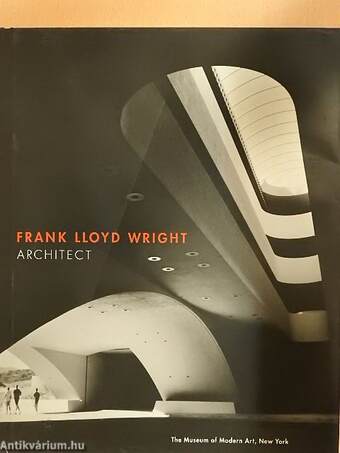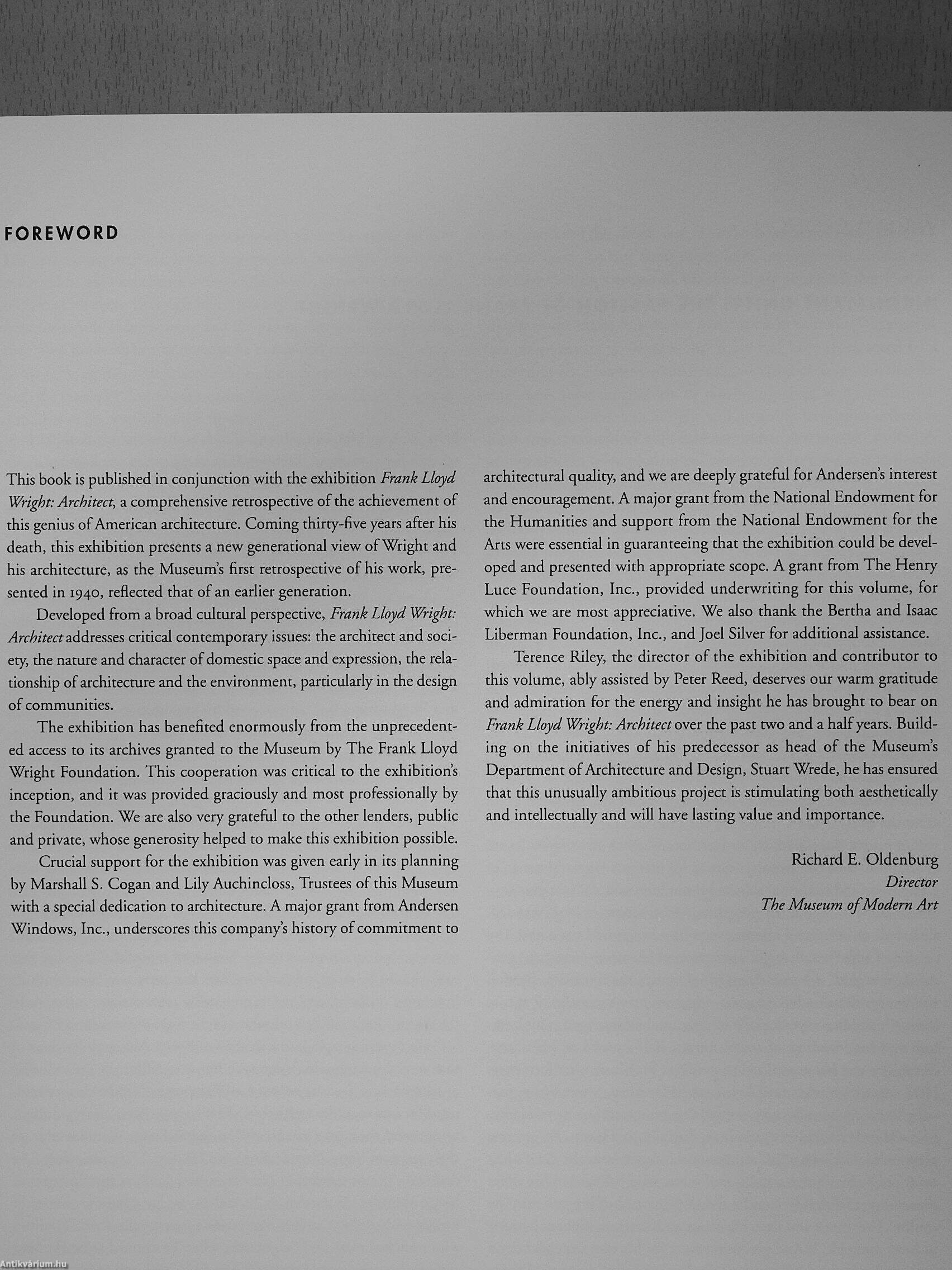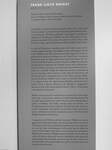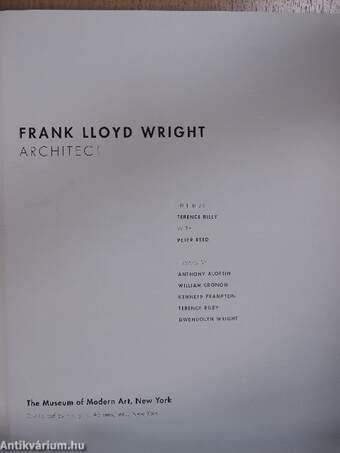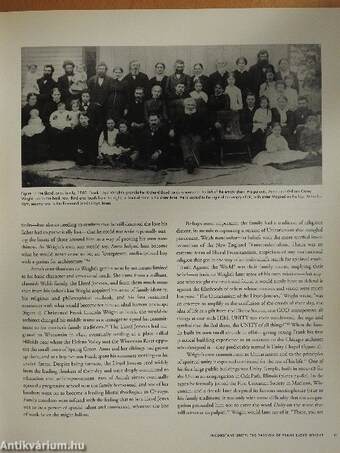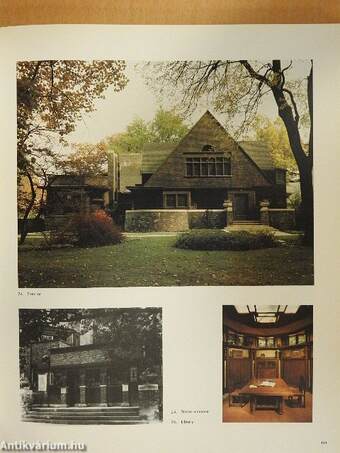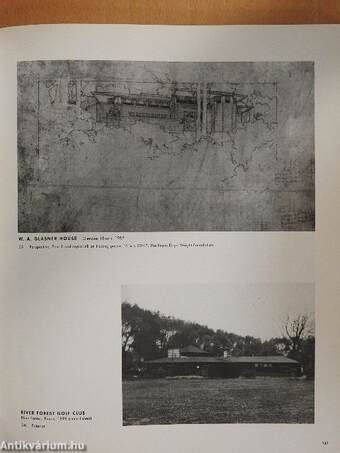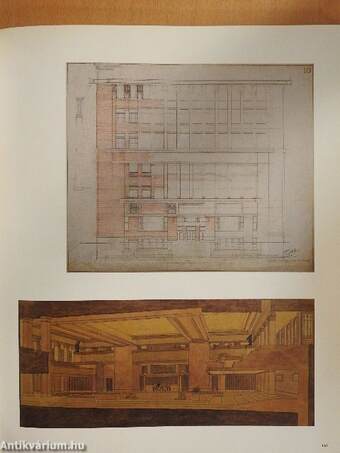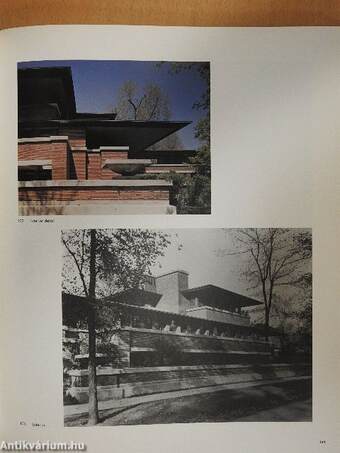1.067.339
kiadvánnyal nyújtjuk Magyarország legnagyobb antikvár könyv-kínálatát

VISSZA
A TETEJÉRE
JAVASLATOKÉszre-
vételek
Frank Lloyd Wright Architect
| Kiadó: | The Museum of Modern Art |
|---|---|
| Kiadás helye: | New York |
| Kiadás éve: | |
| Kötés típusa: | Vászon |
| Oldalszám: | 344 oldal |
| Sorozatcím: | |
| Kötetszám: | |
| Nyelv: | Angol |
| Méret: | 32 cm x 25 cm |
| ISBN: | 0-8109-6122-9 |
| Megjegyzés: | Színes és fekete-fehér fotókkal, ábrákkal. |
naponta értesítjük a beérkező friss
kiadványokról
naponta értesítjük a beérkező friss
kiadványokról
Előszó
TovábbFülszöveg
FRANK LLOYD WRIGHT
ARCHITECT
Edited by Terence Riley with Peter Reed.
Essays by William Cronon, Anthony Alofsin, Kenneth Frampcon, Gwendolyn Wright, and Terence Riley.
Undeniably the greatest architectural genius of his time, Frank Lloyd Wright produced a vast body of work that defined and redefined American architecture. This book, published to accompany a retrospective exhibition at The Museum of Modern Art, New York, presents a comprehensive summary of his vision—from the turn of the century until his death in 1959—and a new assessment of his remarkable achievement.
A wealth of illustrations, including many in full color, present newly restored original drawings of his designs as well as photographs of built works. Wright's residential architecture provided images and models for generations of suburban building across the United States. Among his best known works are single-family houses: the Prairie houses; the California Textile Block houses; Usonian houses for... Tovább
Fülszöveg
FRANK LLOYD WRIGHT
ARCHITECT
Edited by Terence Riley with Peter Reed.
Essays by William Cronon, Anthony Alofsin, Kenneth Frampcon, Gwendolyn Wright, and Terence Riley.
Undeniably the greatest architectural genius of his time, Frank Lloyd Wright produced a vast body of work that defined and redefined American architecture. This book, published to accompany a retrospective exhibition at The Museum of Modern Art, New York, presents a comprehensive summary of his vision—from the turn of the century until his death in 1959—and a new assessment of his remarkable achievement.
A wealth of illustrations, including many in full color, present newly restored original drawings of his designs as well as photographs of built works. Wright's residential architecture provided images and models for generations of suburban building across the United States. Among his best known works are single-family houses: the Prairie houses; the California Textile Block houses; Usonian houses for middle-class America; and spectacular commissions for wealthier clients, such as Fallingwater, the famous house constructed on natural rock and cantilevered dramatically over a waterfall. Wright also explored community planning and low-cost housing, and he executed a wide range of institutional and commercial projects. Among the latter are the Larkin Company Administration Building in Buffalo; Unity Temple in Oak Park, Illinois; the S. C. Johnson & Son, Inc. Administration Building and Research Laboratory Tower in Racine, Wisconsin; the Solomon R. Guggenheim Museum in New York; and the Imperial Hotel in Tokyo—all landmarks in the history of architecture.
Wright's most spectacular commissions are presented in these pages along with a representative selection of works from all periods of his unusually long and productive career. Projects are shown through photographs of buildings and models, through plans and sketches, and through reproductions of the architect's masterful drawings, many previously unpublished. Research for the book has drawn upon many sources, including unrestricted, independent access to The Frank Lloyd Wright Foundation and Archives.
A pragmatist and brilliant technical innovator, Wright was also an aggressively independent thinker and articulate advocate for his views. The essays in this book, by distinguished architectural critics and historians, not only chart the development of his work, but also define the essence of his thought, which had its core in Emersonian spiritualism. Exploring the resonance of Wrights career in twentieth-century American society, the authors discuss his views on individuality and community, craftsmanship and technology, and nature and the built environment; his relationship to European modernism; and his autocratic advocacy of a democratic architecture. Vissza
Témakörök
- Idegennyelv > Idegennyelvű könyvek > Angol > Művészetek > Építészet
- Idegennyelv > Idegennyelvű könyvek > Angol > Művészetek > Fotóművészet
- Művészetek > Építészet > Tanulmányok, esszék
- Művészetek > Építészet > Korszakok, stílusok > XX. század > Egyéb
- Művészetek > Építészet > Idegen nyelv > Angol
- Művészetek > Fotóművészet > Albumok > Tematikus
- Művészetek > Fotóművészet > Idegen nyelv > Angol
- Művészetek > Fotóművészet > Témái > Művészetek
Megvásárolható példányok
Nincs megvásárolható példány
A könyv összes megrendelhető példánya elfogyott. Ha kívánja, előjegyezheti a könyvet, és amint a könyv egy újabb példánya elérhető lesz, értesítjük.



